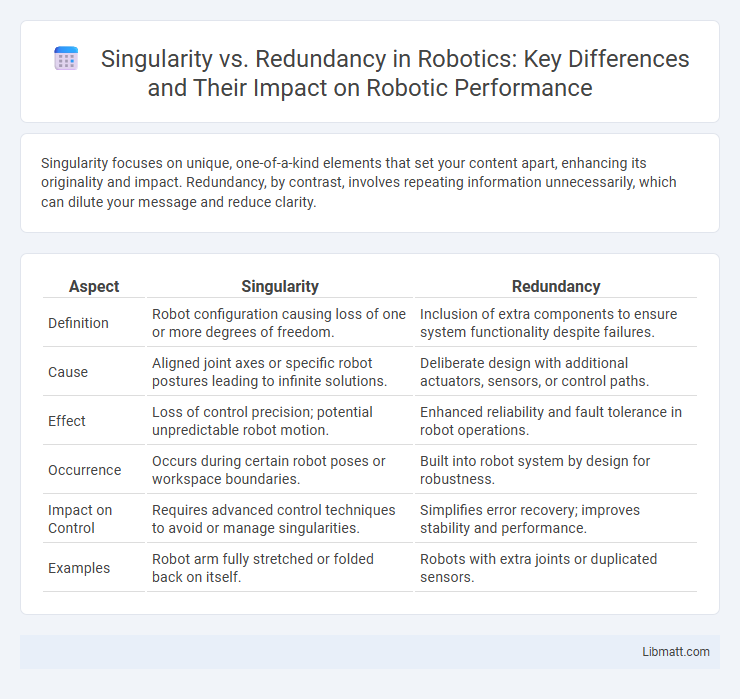Singularity focuses on unique, one-of-a-kind elements that set your content apart, enhancing its originality and impact. Redundancy, by contrast, involves repeating information unnecessarily, which can dilute your message and reduce clarity.
Table of Comparison
| Aspect | Singularity | Redundancy |
|---|---|---|
| Definition | Robot configuration causing loss of one or more degrees of freedom. | Inclusion of extra components to ensure system functionality despite failures. |
| Cause | Aligned joint axes or specific robot postures leading to infinite solutions. | Deliberate design with additional actuators, sensors, or control paths. |
| Effect | Loss of control precision; potential unpredictable robot motion. | Enhanced reliability and fault tolerance in robot operations. |
| Occurrence | Occurs during certain robot poses or workspace boundaries. | Built into robot system by design for robustness. |
| Impact on Control | Requires advanced control techniques to avoid or manage singularities. | Simplifies error recovery; improves stability and performance. |
| Examples | Robot arm fully stretched or folded back on itself. | Robots with extra joints or duplicated sensors. |
Understanding Singularity: Definition and Concepts
Singularity refers to the state of being unique or singular, emphasizing the distinctiveness of an entity without duplicates or alternatives. In information theory and systems design, singularity implies the presence of one definitive solution or outcome, contrasting sharply with redundancy, which involves multiple overlapping components enhancing reliability. Understanding singularity helps you grasp how uniqueness impacts efficiency, decision-making, and system optimization.
Redundancy Explained: Meaning and Importance
Redundancy refers to the inclusion of extra components or systems in a design to ensure continuous operation in case of failure, enhancing reliability and safety. It is critical in industries like aviation, data storage, and telecommunications where uninterrupted performance is essential. Implementing redundancy minimizes downtime and protects against data loss, system crashes, or catastrophic failures.
Historical Context of Singularity and Redundancy
Singularity and redundancy have shaped technological and organizational developments through distinct historical contexts; singularity often refers to unique, pivotal moments such as the Industrial Revolution or the advent of artificial intelligence, where unprecedented changes occur. Redundancy emerged historically as a strategy to ensure reliability and continuity, especially in engineering and information systems, by duplicating critical components. Understanding these concepts helps you appreciate how innovation and risk management have evolved to balance groundbreaking advances with system stability.
Key Differences: Singularity vs Redundancy
Singularity refers to a unique, singular occurrence or state, while redundancy involves duplication or repetition to ensure reliability and fault tolerance. In technology and data management, singularity emphasizes one definitive version or point, whereas redundancy provides backup copies or systems to prevent failure. Understanding the key differences between singularity and redundancy helps you optimize system design by balancing precision with resilience.
Advantages of Singularity in Systems and Processes
Singularity in systems and processes offers streamlined decision-making by reducing complexity and minimizing points of failure, enhancing overall reliability. Centralized control enables faster implementation of updates and improvements, leading to increased efficiency and coherence across operations. Your organization can achieve more consistent outcomes and simplified management, ultimately driving innovation and scalability.
Benefits of Redundancy for Reliability and Safety
Redundancy enhances reliability by providing backup systems that ensure continuous operation even if primary components fail, crucial in aerospace, medical devices, and data centers. Multiple redundant components eliminate single points of failure, significantly reducing the risk of catastrophic system outages or accidents. Safety-critical industries rely on redundancy to maintain system integrity under adverse conditions, thereby protecting human lives and preserving mission-critical functions.
Common Applications: Singularity vs Redundancy
Singularity finds common applications in unique event detection, such as anomaly detection in financial markets and fault identification in manufacturing systems, where pinpoint accuracy is critical. Redundancy is extensively applied in safety-critical systems like aerospace, data centers, and telecommunications to ensure continuous operation despite component failures. Both concepts optimize system reliability but target different operational priorities: singularity emphasizes precise, non-repetitive outcomes, while redundancy safeguards functionality through duplication.
Challenges and Risks: When Singularity Fails
Singularity failure presents significant challenges including system-wide breakdowns due to the lack of fallback mechanisms, resulting in potential loss of critical data and operational downtime. The inherent risk lies in the absence of redundancy, making recovery difficult and increasing vulnerability to catastrophic errors or cyberattacks. Businesses relying solely on singularity models face amplified financial and reputational damage without layered safety nets to mitigate these failures.
Mitigating Failures: Redundant Systems in Practice
Redundant systems mitigate failures by duplicating critical components, ensuring continuous operation despite individual faults. Implementing redundancy in data centers, such as dual power supplies and mirrored storage, enhances system reliability and uptime. This approach reduces downtime risk, enabling seamless performance during hardware or software malfunctions.
Future Trends: Balancing Singularity and Redundancy
Future trends in technology emphasize balancing singularity, which drives innovation through unique, centralized intelligence, with redundancy, ensuring system reliability via duplicated components. Embracing singularity allows for advanced AI capabilities and streamlined decision-making, while redundancy safeguards against failures in critical infrastructure like cloud computing and data centers. Achieving this balance enhances resilience, scalability, and performance in emerging smart systems and autonomous networks.
Singularity vs Redundancy Infographic

 libmatt.com
libmatt.com